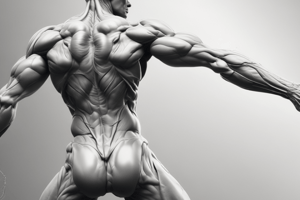Podcast
Questions and Answers
What is the relationship between structure and function in physiology?
What is the relationship between structure and function in physiology?
- Function always determines structure
- They are unrelated concepts
- Structure always determines function
- They are interrelated (correct)
Why do living organisms require energy?
Why do living organisms require energy?
- To perform functions and processes (correct)
- To maintain their structure only
- To coordinate information flow
- To carry out gene expression
How do cells, tissues, organs, and organ systems operate in the body?
How do cells, tissues, organs, and organ systems operate in the body?
- In a vacuum, separate from other body components
- In isolation, without any interaction
- Independently from each other
- By relying on each other for survival (correct)
What is gene expression?
What is gene expression?
Which theme in physiology involves chemical and electrical signals between cells?
Which theme in physiology involves chemical and electrical signals between cells?
Why are the processes and mechanisms in our bodies often a series of cause and effect events?
Why are the processes and mechanisms in our bodies often a series of cause and effect events?
Cells, tissues, and organs can operate independently without relying on each other for survival.
Cells, tissues, and organs can operate independently without relying on each other for survival.
Gene expression involves mRNA providing instructions to make DNA.
Gene expression involves mRNA providing instructions to make DNA.
Information flow plays a role in coordinating the body, such as in gene expression and cell communication.
Information flow plays a role in coordinating the body, such as in gene expression and cell communication.
Homeostasis is not an important concept to explore in physiology.
Homeostasis is not an important concept to explore in physiology.
Living organisms do not need energy for their survival.
Living organisms do not need energy for their survival.
Structure and function in physiology are not interrelated.
Structure and function in physiology are not interrelated.
Flashcards are hidden until you start studying
Study Notes
Structure and Function in Physiology
- Structure and function in physiology are closely interconnected; the shape and arrangement of biological components dictate their roles in bodily processes.
- Each organ’s anatomy supports its specific function, such as the heart's muscular walls enabling effective blood pumping.
Energy Requirements in Living Organisms
- Living organisms require energy to maintain vital activities like metabolism, growth, and reproduction.
- Energy is essential for processes such as cellular respiration, muscle contraction, and nerve impulse transmission.
Organization of Biological Systems
- Cells assemble into tissues, which form organs, and multiple organs create organ systems, each with specialized functions.
- For example, muscle cells comprise muscle tissue, contributing to the function of the heart, an organ essential for circulation.
Gene Expression
- Gene expression is the process by which information from a gene is used to produce a functional product, typically proteins guided by mRNA.
- This process involves transcription of DNA into mRNA, followed by translation to synthesize proteins.
Communication Between Cells
- The theme of chemical and electrical signals between cells is fundamental to physiology, known as cell communication.
- Neurons transmit electrical impulses while hormones serve as chemical messengers, coordinating bodily functions.
Cause and Effect Mechanisms
- Physiological processes often follow a chain of cause and effect, where one event triggers subsequent reactions, ensuring efficient functioning.
- For example, a stimulus may prompt a neurological response, leading to a physical action.
Homeostasis
- Homeostasis refers to the body’s ability to maintain a stable internal environment despite external changes, an essential concept in physiology.
Misconceptions
- Cells, tissues, and organs generally do not operate independently; they rely on each other for overall survival and functionality.
- Living organisms must acquire energy for survival; it’s a critical requirement rather than a dispensable aspect.
- The structure-function relationship is a fundamental principle in physiology, challenging the notion that they are unrelated.
Studying That Suits You
Use AI to generate personalized quizzes and flashcards to suit your learning preferences.



